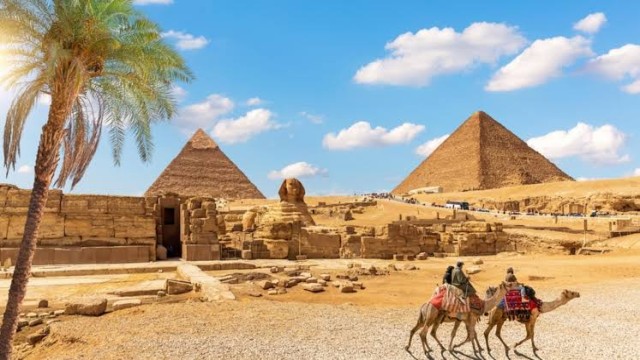Step into the realm of ancient mysteries as we embark on a journey to unravel the secrets of the Giza Pyramid. Standing proudly on the Giza Plateau for over 4,500 years, this enigmatic structure continues to captivate the imagination of scholars and adventurers alike. Join us as we delve deep into the heart of one of the world's most iconic landmarks, exploring its construction, purpose, and enduring mysteries. From precision engineering to hidden chambers, the Giza Pyramid holds countless secrets waiting to be uncovered. Let us embark on this fascinating expedition together, as we seek to shed light on the mysteries of the ancient world.
.jpeg)
1. Introduction: The Giza Pyramid, also known as the Pyramid of Khufu or the Great Pyramid, is arguably one of the most iconic and enigmatic structures in human history. Standing tall on the Giza Plateau near Cairo, Egypt, this ancient wonder has captured the imagination of scholars, explorers, and tourists alike for centuries.
2. Construction Techniques: The construction of the Giza Pyramid is a marvel of ancient engineering. The pyramid is composed of an estimated 2.3 million limestone blocks, each weighing several tons. These blocks were quarried from nearby sites and transported to the pyramid complex, where they were meticulously arranged to form the structure we see today.
3. Precision Engineering: One of the most perplexing aspects of the Giza Pyramid is the precision with which it was built. Despite the immense size of the blocks, they fit together with astonishing accuracy, leaving only tiny gaps between them. This level of precision is unprecedented in ancient architecture and has led many to wonder how the ancient Egyptians achieved such feat.
4. Alignment with the Cardinal Points: One of the most intriguing features of the Giza Pyramid is its near-perfect alignment with the cardinal points of the compass. The sides of the pyramid are oriented precisely to the north, south, east, and west, with only a minuscule margin of error. This precise alignment has led some researchers to suggest that the pyramid was designed with astronomical significance.
.jpeg)
5. Theories on Purpose: While the mainstream consensus is that the Giza Pyramid served as a tomb for Pharaoh Khufu, alternative theories abound. Some researchers argue that the pyramid had a more symbolic or religious purpose, perhaps serving as a monument to the pharaoh's divine authority or as a representation of the primordial mound from which the Egyptians believed the world was created.
6. Chambers and Passageways: Within the Giza Pyramid are several chambers and passageways, each holding its own mysteries. The King's Chamber, located near the center of the pyramid, is perhaps the most well-known. It contains an empty granite sarcophagus, leading some to speculate about its purpose. The Queen's Chamber, located higher up in the pyramid, is smaller and less ornate but equally enigmatic.
7. Hidden Shafts and Chambers: Throughout the pyramid are a series of hidden shafts and chambers that have puzzled researchers for centuries. These passages, some of which extend from the main chambers to the outer surface of the pyramid, have been the subject of much speculation and intrigue. Some believe they served a religious or ritualistic purpose, while others suggest they were part of the pyramid's ventilation system.
8. Symbolism and Iconography: The Giza Pyramid is adorned with various symbols and hieroglyphs, each carrying its own meaning and significance. These inscriptions offer tantalizing clues about the beliefs and practices of the ancient Egyptians but also raise questions about the pyramid's intended purpose.
9. Theories of Construction: Despite the prevailing belief that the Giza Pyramid was built by tens of thousands of laborers over a span of 20 years, some researchers have proposed alternative theories. These include the idea that the pyramid was constructed using advanced technology or assistance from extraterrestrial beings. While such theories are often dismissed as speculative, they continue to capture the imagination of conspiracy theorists and enthusiasts alike.
.jpeg)
10. Ongoing Research and Exploration: Despite centuries of study, much about the Giza Pyramid remains shrouded in mystery. Ongoing research and exploration efforts, including advanced imaging techniques and archaeological excavations, offer hope that we may one day unlock the secrets hidden within its ancient walls.
11. Tourist Attraction and Cultural Significance: Today, the Giza Pyramid is a UNESCO World Heritage Site and a popular tourist destination, attracting millions of visitors from around the world each year. Its enduring allure and cultural significance ensure that it will continue to captivate the hearts and minds of people for generations to come.
12. Legacy and Influence: The Giza Pyramid's influence extends far beyond its physical presence on the Egyptian landscape. It has inspired countless works of art, literature, and popular culture, serving as a symbol of human achievement and ingenuity.
13. Preservation Efforts: In recent years, efforts have been made to preserve and protect the Giza Pyramid and its surrounding complex. These efforts include conservation projects, improved visitor management, and measures to mitigate the impact of tourism on the fragile archaeological site.
14. Educational Outreach: Institutions such as the Egyptian Ministry of Antiquities and various archaeological organizations are committed to educating the public about the importance of preserving cultural heritage sites like the Giza Pyramid. Through outreach programs, exhibitions, and educational initiatives, they seek to raise awareness and foster appreciation for Egypt's rich history and heritage.
15. Cultural Significance: The Giza Pyramid holds immense cultural significance for the Egyptian people and people around the world. It serves as a symbol of Egypt's ancient civilization and its enduring legacy, reminding us of the achievements of our ancestors and the mysteries that still await discovery.
.jpeg)
16. Interdisciplinary Research: The study of the Giza Pyramid is a truly interdisciplinary endeavor, bringing together archaeologists, historians, engineers, astronomers, and other experts from various fields. By collaborating and sharing knowledge, these researchers hope to unravel the mysteries of this ancient monument and gain a deeper understanding of the civilization that created it.
17. International Collaboration: Research on the Giza Pyramid often involves collaboration between Egyptian authorities and international institutions and experts. This collaborative approach fosters cross-cultural exchange and mutual learning, enriching our understanding of the pyramid's significance and its place in human history.
18. Technological Advancements: Advances in technology, such as LiDAR scanning, ground-penetrating radar, and 3D modeling, have revolutionized the study of ancient monuments like the Giza Pyramid. These tools allow researchers to explore hidden chambers, map underground structures, and analyze architectural details with unprecedented precision.
19. Public Interest and Engagement: The enduring fascination with the Giza Pyramid speaks to its universal appeal and relevance. Public interest in the pyramid's mysteries has sparked numerous documentaries, books, and online discussions, further fueling curiosity and speculation about its origins and purpose.
20. Ethical Considerations: As interest in the Giza Pyramid continues to grow, it is essential to consider the ethical implications of research and tourism. Balancing the preservation of cultural heritage with the need for scientific inquiry and economic development is a complex challenge that requires careful consideration and collaboration among stakeholders.
21. Cultural Diplomacy: The Giza Pyramid serves as a symbol of Egypt's cultural heritage and identity on the global stage. By promoting the pyramid's preservation and study, Egypt enhances its soft power and fosters cultural diplomacy with other nations.
.jpeg)
22. Inspiration for Future Generations: The Giza Pyramid continues to inspire awe and wonder in people of all ages. By learning about its history and significance, future generations can be inspired to explore the mysteries of the past and contribute to our collective understanding of human civilization.
23. The Quest for Knowledge: Ultimately, the study of the Giza Pyramid is driven by humanity's innate curiosity and thirst for knowledge. As we unravel the mysteries of this ancient monument, we gain insight into the ingenuity, creativity, and resilience of our ancestors, while also confronting the limitations of our own understanding.
24. Continued Exploration and Discovery: The exploration of the Giza Pyramid is an ongoing endeavor that holds the promise of new discoveries and revelations. As technology advances and our methods of investigation become more sophisticated, we are constantly uncovering new information about this ancient wonder.
25. Legacy for Future Generations: The legacy of the Giza Pyramid extends far beyond its physical structure. It serves as a symbol of human achievement and perseverance, reminding us of the incredible feats that can be accomplished with determination and ingenuity. By preserving and studying the pyramid, we ensure that its legacy endures for generations to come, inspiring future scholars, explorers, and dreamers to unlock the mysteries of our past.
.jpeg)
As our exploration of the Giza Pyramid draws to a close, we are left with more questions than answers. Despite centuries of study, this ancient wonder continues to defy explanation, its secrets shrouded in the sands of time. Yet, our journey has not been in vain. Through collaboration, innovation, and a shared passion for discovery, we have gained invaluable insights into the ingenuity and creativity of our ancient ancestors. The legacy of the Giza Pyramid endures as a testament to human achievement, inspiring awe and wonder in all who behold its majestic splendor. As we bid farewell to this ancient marvel, we are reminded that the quest for knowledge knows no bounds, and the mysteries of the past will continue to beckon us into the future.































Comment: